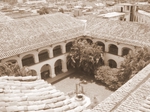
- Travel To Camaguey
- Rooms to let
- Camaguey City
- Images
- How to get
- traveler tools
- Events in Camaguey
- Camaguey's Map
- Car Rentals
- Santa Lucia Beach
- Rent Rooms Havana

The arrival of the Sevillian colonists (experienced farmers) in 1516 made the villa move into fertile lands (Florida municipality).
By the dawn of 1528 a new exodus led the villa southwards… to Camaguey. The village was in the middle of the already quite known path between Sancti Spiritus and Bayamo. Placed between the rivers Hatibonico and Tinima, this new and final settlement was known simply as Puerto del Principe in the 16th century. But soon afterwards the name also shrank into Puerto Principe.
Camaguey, its official name since 1903, is a colonial city that still has much of its past charm. Camaguey has a legendary and well deserved place in history because of the many outstanding patriots and gorgeous women it has given birth to.
Its old city resembles an Andalusian Christian Muslim city due to its many narrow and winding streets which lead to plazas and small squares flanked most of them by a parochial church. Its old city is the largest in Cuba and the Caribbean. Clay was the predominant material in walls, in roofs, in patios and in tinajones.
Nowadays, Camaguey City is the second most largest urban center in Cuba (70,5 sq. km.), only surpassed by Havana, the capital city of Cuba. Its population of 300,000 inhabitants is only surpassed by those of Havana and Santiago de Cuba. The winding outline got its present form by the middle of the 19th century.
What does Camaguey mean?
Regarding the old Indocuban language, its origin might be:
CAMAGUA + EY
The camagua [Wallenia lauriformia (Jacq.), Sw.] is a nether-land wild bush. It is found throughout the island and it receives several popular names. The ending EY (EX, EL) was used to state the origin, e.g., the lineage, the ancestry. Therefore, the voice CAMAGUEY might state the magic-religious origin of this bush which it was regarded as the cradle of the caciques of this territory which at the same time was called after them.
Contact us
Any questions about our site?, please contact us.
Search
in this site...
Compilation of marvelous pictures of Camaguey city and its most interesting places. Panoramic views of the old colonial city. Each image described as well as excellent zooms...
Events in Camaguey
Copyright © 2006-2012 CamagueyRentals.com | Terms & Conditions | Privacy Policy | Travel Directory
